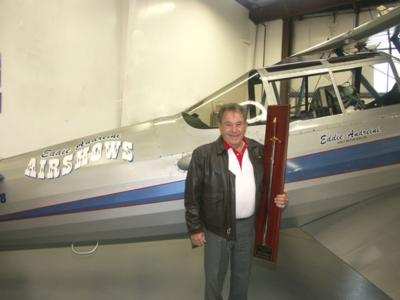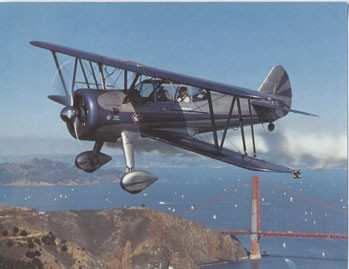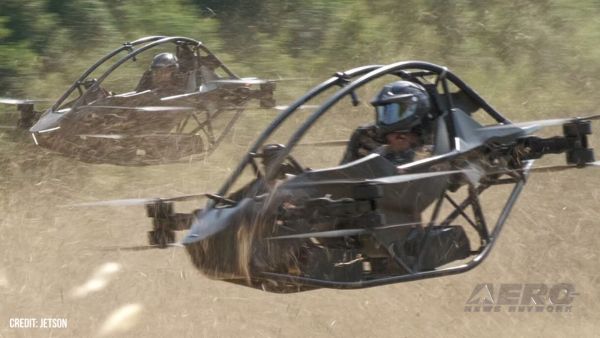Air Show Pilot Eddie Andreini Was Attempting A Ribbon-Cutting Maneuver
We marvel at their skill, and that may be why we are so shocked when something goes horribly wrong. The NTSB released its preliminary report from such a fatal accident that occurred May 4 at Travis AFB during the "Thunder Over Solano" open house involving air show pilot Eddie Andreini.

According to the report, at about 1359 Pacific daylight time, a Boeing E75 Stearman, N68828, was destroyed when it impacted runway 21R during an aerial demonstration flight at Travis Air Force Base (SUU), Fairfield, California. The commercial pilot/owner received fatal injuries. The exhibition flight was operated under the provisions of Title 14 Code of Federal Regulations Part 91. Visual meteorological conditions prevailed, and no flight plan was filed for the flight.
The pilot was one of several civilian aerial demonstration pilots who performed at the two-day SUU "Thunder Over Solano" open house, which included both static (ground) and aerial (flight) displays. According to USAF and FAA information, Friday May 2 was the practice day, while the public event took place on Saturday and Sunday, May 3 and 4. The pilot flew two flight demonstration airplanes at the event, a North American P-51, and the accident airplane. All his flights preceding the accident flight were uneventful.
The accident occurred during a "ribbon-cut maneuver," whereby a ribbon was suspended transversely across the runway, between two poles held by ground crew personnel, and situated about 20 feet above the runway. The planned maneuver consisted of a total of three passes. The first two passes were to be conducted with the airplane upright, and were not planned to contact the ribbon. The final pass was to be conducted inverted, and the airplane would cut the ribbon with its vertical stabilizer. The first two passes were successful, but on the third (inverted, ribbon-cut) pass, the airplane was too high, and did not cut the ribbon. The pilot came around for a fourth pass, and rolled the airplane inverted after aligning with the runway. The airplane contacted the runway prior to reaching the ribbon, slid inverted between the ground crew personnel holding the poles, and came to a stop a few hundred feet beyond them.
Ground scars consisted of rudder/ vertical stabilizer ("tail") and upper wing contact (metal and wood scrapes, and paint transfer) with the runway, as well as propeller "slash marks" approximately perpendicular to the direction of travel. Review of image and ground scar data indicated that the airplane first contacted the runway with its right wing, followed by the tail, the left wing, and then the propeller.
The upper outboard right wing initial scar was followed about 7 feet later by the tail strike, and then a few feet later by the upper left wing. The initial tail strike was located about 45 feet right (northeast) of the runway centerline, about 380 feet beyond the runway threshold. The initial direction of travel was aligned approximately 5 degrees to the right (divergent from) the runway axis. The propeller slash marks began about 100 feet beyond the initial tail strike, and continued to the final resting location of the airplane. The slash marks described an arc, which curved to the left, and which resulted in the airplane coming to rest near the left (southwest) edge of the runway, on a magnetic heading of about 140 degrees. The airplane slid a total distance of about 740 feet.
Review of still and moving images indicated that fire became visible just before the airplane came to a stop, and that the fire patterns were consistent with a pool fire of spilled fuel. Within about 50 seconds, the fire encompassed most of the right (downwind) side of the airplane. USAF rescue and firefighting vehicles and personnel arrived at the airplane about 3 to 4 minutes after the accident, and extinguished the fire.

Federal Aviation Administration (FAA) information indicated that the airplane was manufactured in 1944, and was first registered to the pilot in 1982. The airplane was equipped with a Pratt & Whitney R-985 series engine. The fuselage and empennage consisted of a synthetic-fabric covered steel tube structure, while the wings were primarily wood structure covered with the same type of fabric. The 47-gallon fuel tank was mounted in the center section of the upper wing, just forward of the cockpit.
The cockpit was enclosed by a canopy, which consisted of a metal frame and plastic transparencies. The longitudinal section of the canopy consisted of one fixed section (right side) and two movable sections (top and left side). The top section was longitudinally hinged to the fixed right section and the movable left section, and the forward and aft bottom corners of the left section rode in transverse tracks at the forward and aft ends of the cockpit. That design allowed cockpit entry and egress by operating the top and left canopy sections in a manner similar to a bi-fold door; which required clearance above the canopy for the canopy to be opened.
Preliminary examination of the wreckage indicated that most of the fabric covering on the fuselage was damaged or consumed by fire. The right wing and cockpit furnishings were almost completely consumed by fire, as were some of the aluminum flight control tubes. The left wing and rudder /vertical stabilizer sustained impact deformation, but the cockpit occupiable volume was not compromised by deformation of any surrounding structure.
According to FAA information, the pilot held single- and multi-engine airplane, and instrument airplane ratings, and was authorized to fly several experimental airplanes. His most recent FAA second class medical certificate was issued in June 2013.
The SUU 1358 automated weather observation included wind from 240 degrees at 15 knots gusting to 21, visibility 10 miles, few clouds at 18,000 feet, temperature 22 degrees C, dew point 12 degrees C, and an altimeter setting of 29.99 inches of mercury.
(Images from file)
 ANN's Daily Aero-Term (07.12.25): Secondary Radar/Radar Beacon (ATCRBS)
ANN's Daily Aero-Term (07.12.25): Secondary Radar/Radar Beacon (ATCRBS) ANN's Daily Aero-Linx (07.12.25)
ANN's Daily Aero-Linx (07.12.25) ANN FAQ: Turn On Post Notifications
ANN FAQ: Turn On Post Notifications Classic Aero-TV: Of the Aeropup and its Pedigree
Classic Aero-TV: Of the Aeropup and its Pedigree Airborne 07.07.25: Sully v Bedford, RAF Vandalism, Discovery Moving?
Airborne 07.07.25: Sully v Bedford, RAF Vandalism, Discovery Moving?




